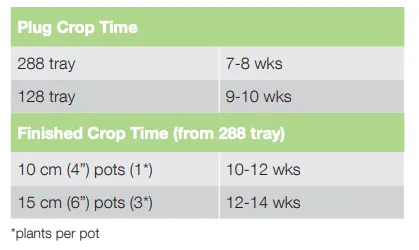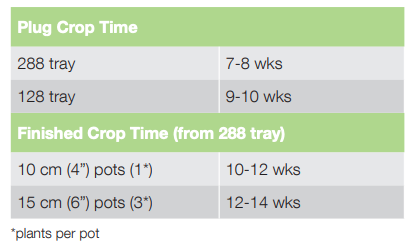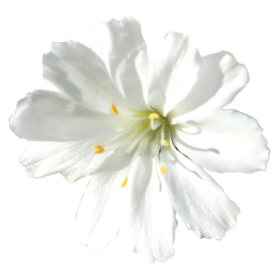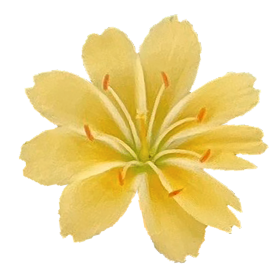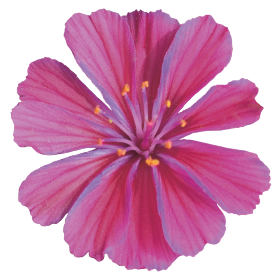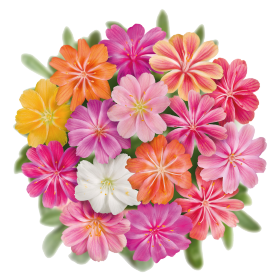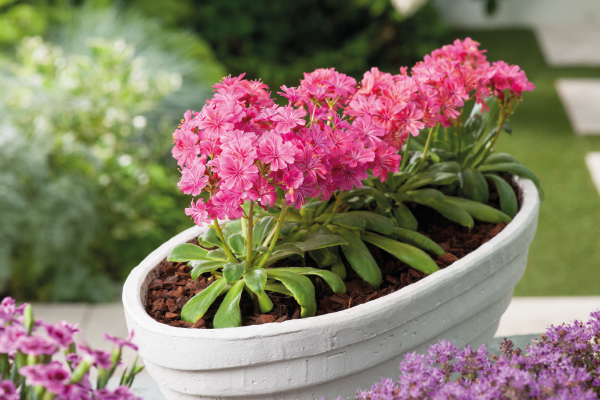
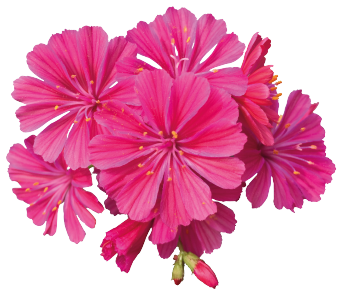
Elise Ruby Red
Item no.: LC0301T- FastraX perennial: First year flowering without vernalization
- Fleuroselect Gold Medal winners in the series
- Long flowering season
- Heat and drought tolerant
- Lighting up beds, containers and rock gardens
- Optimal storage: up to 6 months at 5 °C / 41 °F
- Crop Time
- Spring: 18 - 22 weeks
- Height ∅
- 5 ″ / 13 cm
- Width ∅
- 7 ″ / 18 cm
- Exposure
- Sun - Partial shade
- Seed Form
- ApeX
- Heat Zone
- undetermined
- Hardiness Zone
- 3a-8b
- Product Use
- Pots, Jumbo Packs, Mixed Containers, Bedding, Borders, Rockery
- Family, Origin
- Montiaceae (Portulacese), NW Africa
- Minimum Germ. Rate
- 75%
Technical Guide
Flowering Type: FastraX perennial – first year flowering plants without vernalization. Facultative long day plant. Long days and high light levels will facilitate earlier flowering.
Flowering Mechanism: Maturity of the plant having 6-8 true leaves and high irradiance, with long day’s will initiate flowering. Will flower reliably in the first year without vernalization.
Germination: Optimum conditions for seedling development, beginning on the day of sowing until radicle emergence. Expect radicle emergence in 14-21 days.
Cover: Cover seed with a light layer of medium vermiculite.
Sowing method: 1 seed per plug
Media: pH 5.5-6.0; EC < 0.5. Lewisia are sensitive to high salts in the media.
Temperature: Maintain 18-20 °C (64-68 °F) until root emergence.
Moisture: Keep substrate saturated (5) for the first 10 days, then reduce to a wet (4) until radicle emergency. After radicle emergence has occurred allow the media to dry back to moist (3).
Humidity: 95-100% until root emergence; then reduce to 40-60%. Provide proper ventilation and horizontal airflow to improve oxygen levels in the media.
Light: Lighting is not required for germination but can be beneficial if using a germination chamber. Providing a light source of 10-100 ft. candles (100-1,000 lx) will reduce stretch and improve quality. When moving plugs into the greenhouse, keep light levels at 4-6 mol/m² /day (1,500-2,000 ft. candles or 15,000-20,000 lx). Avoid direct sunlight to prevent damage.
Fertilizer: Maintain EC < 0.5. Fertilized water should not exceed an EC of 0.5. After germination has occurred fertilize with a complete fertilizer (14-4-14) or (15-5-15) at 50 ppm N.
Plug Bulking and Flower Initiation: Optimum conditions during the vegetative stage from cotyledon expansion to flower initiation. This stage is when the seedlings root to the edge of the plug and reach the 6-8 true leaf stage where flower initiation occurs.
Media: pH 5.5-6.0; EC 1.0-1.2
Light: 8-10 mol/m²/day (2,500-3,000 ft. candles or 25,000-30,000 lx). As plants mature to the 6-8 true leaf stage, light levels can be increased further to 12-14 mol/m² /day (3,500–4,000 ft. candles or 35,000-40,000 lx).
Temperature: 17-20 °C (63-68 °F).
Moisture: Maintain a moist (3) substrate, and avoid excessive watering. Roots are slow growing so allow the media to approach a medium (2) before re-saturating to a moist (3).
Fertilizer: Maintain EC 1.0-1.2. Excessive N can lead to stretching and soft growth. Begin feeding weekly using a complete fertilizer (15-5-15) at 100 ppm N. Rates can be increased up to 150 ppm N as seedlings develop.
Growth Regulators: No growth regulators should be necessary.
Fungicides: Use of a preventative fungicide is recommended to control soil-borne diseases. Use recommended rates on the label.
Media: pH 5.5-5.8; EC 1.2-1.5
Light: Provide 12-14 mol/m² /day (3,500-4,000 ft. candles or 35,000-40,000 lx) for the fastest finish.
Temperature: Finish plants cooler at 10-18 °C (50-64 °F) for best quality. As plants begin to flower the temperature can be increased.
Moisture: Maintain an even moisture level as close as possible to moist (3) throughout production. Allow the media moisture level to reach a medium (2) before re-saturating to a moist (3). Roots are slow to develop so use care not to over water. Water thoroughly periodically to even up the crop and then begin to dry plants back with spot watering.
Humidity: 40-60% humidity is ideal. Providing good ventilation and horizontal airflow will help lower the humidity and dry back the media, providing oxygen to the roots.
Fertilizer: Maintain EC 1.2-1.5. Excessive N can lead to stretching and soft growth. Fertilize weekly using a complete fertilizer (15-5-15) or a (17-5-17) under high light levels at 150 ppm N.
Growth Regulators: With proper temperature and moisture management, there should be no need for growth regulators. If needed, apply B-nine (daminozide) as a spray at 2,500 ppm.
Fungicide: Apply fungicides during long periods of low light and high humidity.
Common Diseases: Botrytis. Provide adequate ventilation and air circulation between plants.
Pests: Primarily aphids and thrips.
Post Harvest to Maintain Quality: Fertilize with potassium nitrate at 100 ppm 1-2 weeks prior to shipping.
Moisture Codes
| Saturated (5) | Water is easily observed when finger is pressed on cell. Water moves freely from the top of the plug to the bottom. |
| Wet (4) | Media looks black and is not glistening. The media feels wet to the touch but there is very little water movement. |
| Moist (3) | Water is not easily visible. When finger is pressed on the cell there is very little movement from top to bottom. |
| Medium (2) | Media is not black, but now looks medium brown. There is no water movement when pressed with finger. |
| Dry (1) | Media has changed color to a very light brown and is dry to the touch. |
All information in our technical guide is based on our own trials and would therefore be as guideline only. Detailed cultivation aspects vary depending on climate, location, time of year and environmental conditions. Benary expressly disclaims any responsibility for the content of such data/information and makes no representation or warranty for the cultivation of any products listed. It is recommended that growers conduct a trial of products under their own conditions.


